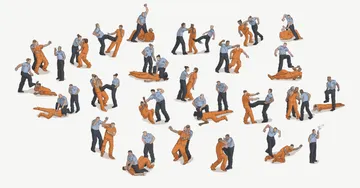This is The Marshall Project’s Closing Argument newsletter, a weekly deep dive into a key criminal justice issue. Want this delivered to your inbox? Subscribe to future newsletters.
On Wednesday, the Los Angeles County Board of Supervisors declared a “local emergency” at the Los Padrinos Juvenile Hall, allowing officials to reassign some of the county’s workforce to cover roles at the chronically understaffed youth detention facility. It was an unusual use of the power, which is typically reserved for disasters like fires and extreme weather. The board argued that the action was warranted to prevent the county from being forced to release the roughly 250 young people incarcerated there “onto the streets.”
The decision to use emergency powers to keep the hall open was a far cry from a sweeping 2020 reform package supported by the board that aimed to close the county’s juvenile halls by 2025 and instead place youths into smaller, more homelike “safe and secure healing centers.” That effort has mostly stalled due to legal constraints and a lack of funding, with the first healing center — which can serve about six young people — slated to open next year. The emergency decision also puts the county at odds with the state of California, which had previously ordered the beleaguered Los Padrinos facility to close earlier this month after a failed inspection found inadequate staffing and dangerous conditions. Thus far, the county has refused to comply.
Los Angeles County is one of many places across the country to backtrack on youth justice reforms in recent months, following a broader pattern of backlash against changes designed to make criminal justice less punitive — most notably in November’s general election.
Take North Carolina, where this summer lawmakers clawed back “raise the age" legislation passed in 2022, which had aimed to keep minors out of the adult justice system. The new law, which went into effect on Dec. 1, automatically treats many 16- and 17-year-olds charged with certain felony offenses as adults.
The change comes as the state is defending itself in a lawsuit that claims teens in detention facilities are being held in isolation for periods of 23 to 24 hours a day, troubling youth advocates. “We are only aggravating any existing problems by placing these very vulnerable kids in isolation,” Jake Sussman, a legal expert, told reporter Rachel Crumpler. “It is the opposite of taking a public health approach, the opposite of thinking about somebody’s well-being and rehabilitation.”
Officials in the state deny a practice of regularly holding young people in solitary confinement, but like many youth justice systems, they say they are stretched thin by understaffing and a marked increase in the youth detention population. From 2019 to 2023 the average daily population in state youth detention increased by more than 150%, and the department has experienced staff vacancy rates of nearly 75% for some positions, North Carolina Health News reported earlier this month.
One of the reasons for the increased numbers of youths in the North Carolina system is the expected result of reforms intended to keep older teens out of adult prisons — thus leaving them in the care of the youth system. The same is true in New York State, where numbers at some secure facilities have increased by 200% following a 2018 change to raise the age of criminal responsibility to 18. New York City’s detention centers have also seen a larger population and increased violence, according to an October report from the city’s Department of Investigation.
Meanwhile, in Colorado, prosecutors want to increase the total number of beds in the state’s youth detention centers by 50% to address what they say is rising juvenile-related violent crime. The current number of available beds was set by a 2021 law that lowered the number to force counties to “let youth out that shouldn’t be there,” according to one bill sponsor.
Washington State is also facing what Democratic Gov. Jay Inslee has called an “avalanche” of young people entering the justice and detention systems. To address overcrowding, Inslee has proposed repurposing an empty building at an adult prison. Youth legal advocates have expressed alarm, noting that the building was formerly used for solitary confinement, has no classrooms, no place for vocational training or even views of greenery from behind foggy-paned windows.
Four years ago, the state pledged something very different when Inslee signed a suite of laws known as “Juvenile Rehabilitation to 25.” The reforms were supposed to create a healing environment and provide intensive education, counseling and drug treatment. The efforts have gone mostly unrealized, according to an op-ed by The Seattle Times editorial board, which concluded that “despite pretty words about wanting a ‘trauma-informed’ and ‘developmentally appropriate, therapeutic’ placement for young people, the state does not have the will to do the hard work of youth rehabilitation.”
And in Louisiana, where “raise the age” legislation was also rolled back in April, it was reported this week that towns across the state are clamoring for a piece of “a new correctional construction boom.” The state has set aside upward of $150 million for new buildings, and juvenile facilities will be given priority, reported The Lens.
In all the above cases, the belief that youth crime is on the rise at least partially informs the rollbacks and efforts to find new detention space. Whenever this newsletter discusses whether crime rates are up or down, we like to remind readers that the answer is complicated by at least three questions: What do we mean by crime, where and over what period of time? Those cautions apply to understanding youth crime as well. An analysis published this fall by the non-partisan Council on Criminal Justice found that youth crime is generally on the decline, with one glaring exception: Youth homicide climbed by 65% from 2016 to 2022, mirroring increases in violent victimization of young people.
In Maryland, another state that reversed juvenile justice reforms this year, a study by The Sentencing Project — an anti-incarceration advocacy group — found that local media outlets “mischaracterized isolated short-term increases from artificially low offending rates during the pandemic as a major new teen crime wave,” helping to spur the public and legislative backlash.
This week, Kevin T. Brown, an incarcerated writer in the state, gave his view in The Baltimore Sun, about ongoing efforts to undo more recent youth justice reforms. “I have been incarcerated for over 33 years and am the product of [the]… ‘lock ’em up and throw away the key’ approach to the youth violence problem. Now, it seems that nothing has been learned from this failed strategy.”

